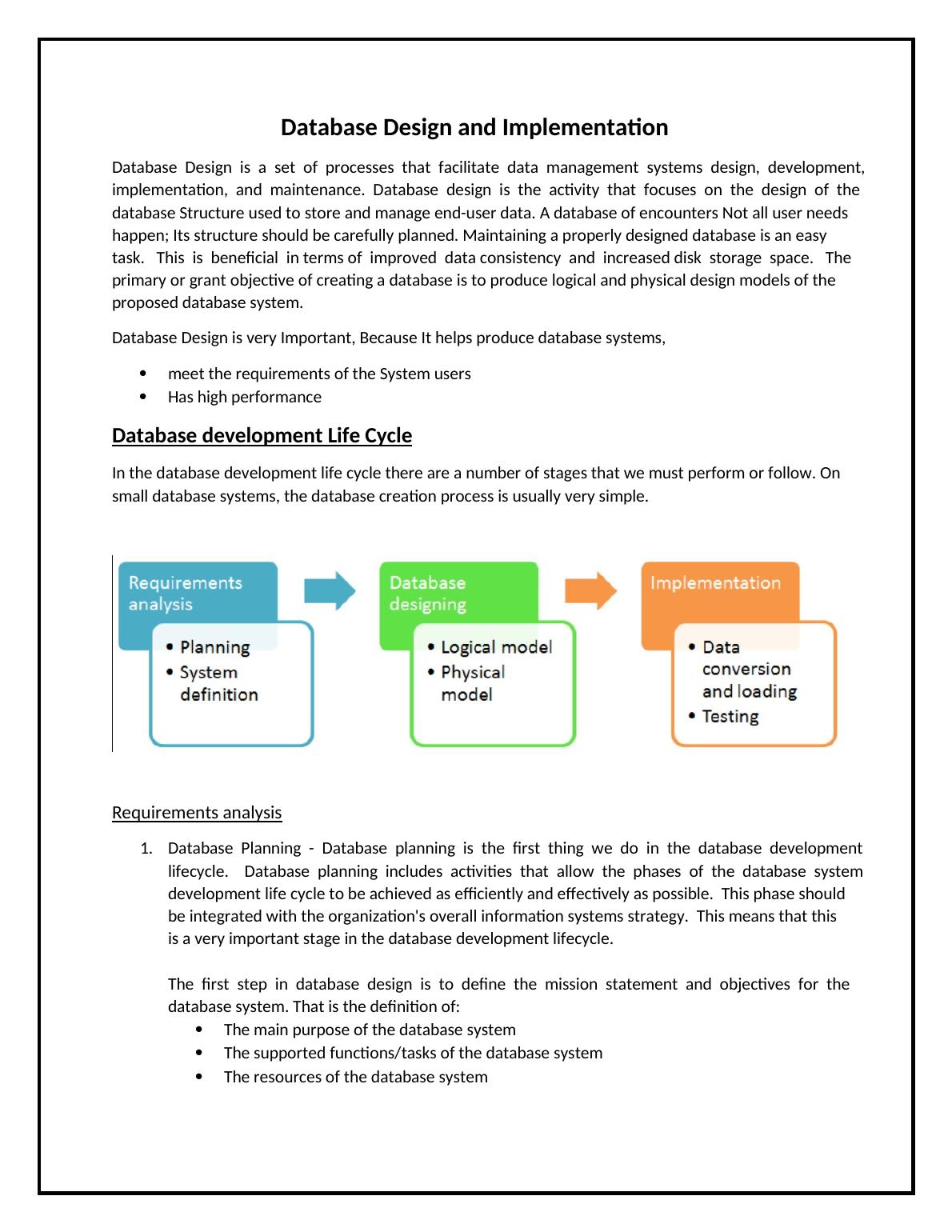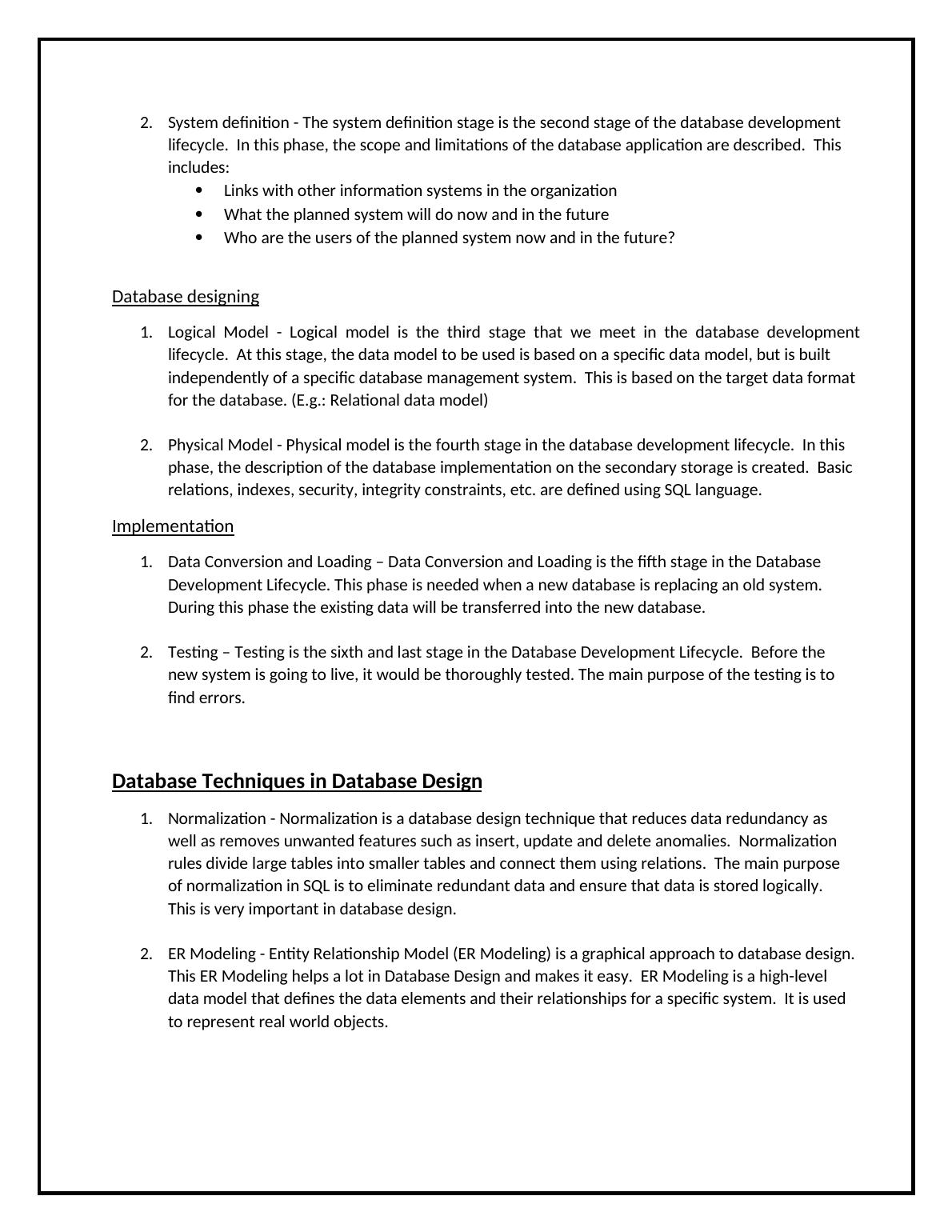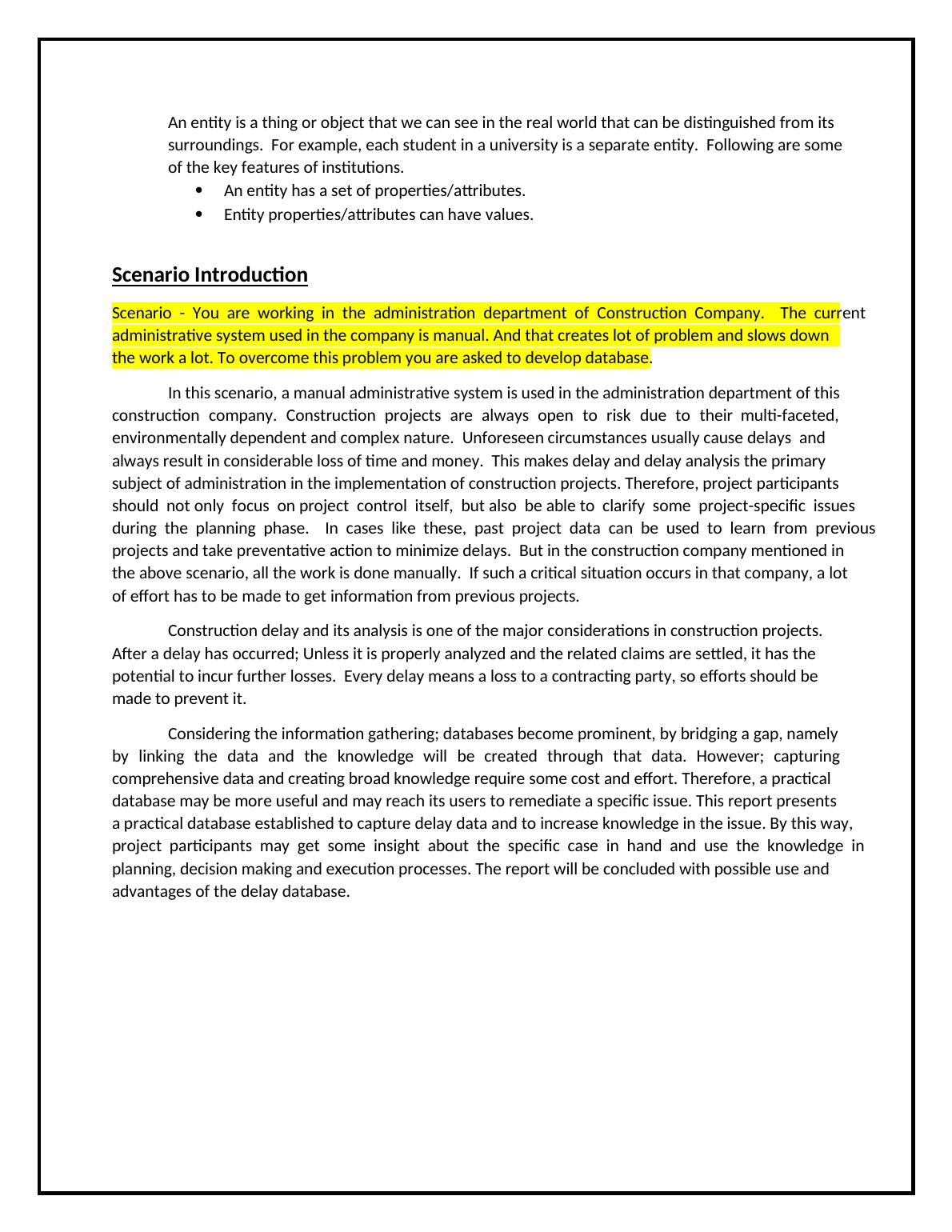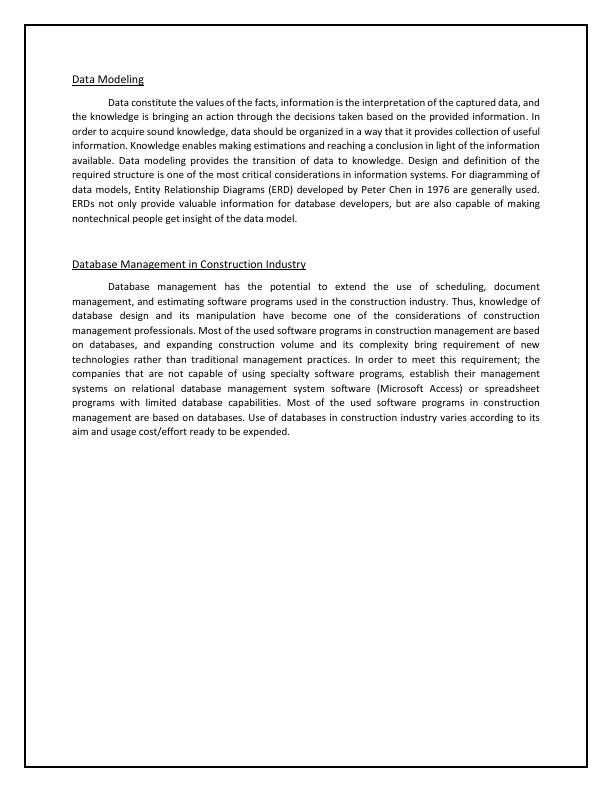Database Design and Implementation
Added on 2022-11-18
18 Pages3425 Words15 Views
Database Design and Implementation
Database Design is a set of processes that facilitate data management systems design, development,
implementation, and maintenance. Database design is the activity that focuses on the design of the
database Structure used to store and manage end-user data. A database of encounters Not all user needs
happen; Its structure should be carefully planned. Maintaining a properly designed database is an easy
task. This is beneficial in terms of improved data consistency and increased disk storage space. The
primary or grant objective of creating a database is to produce logical and physical design models of the
proposed database system.
Database Design is very Important, Because It helps produce database systems,
meet the requirements of the System users
Has high performance
Database development Life Cycle
In the database development life cycle there are a number of stages that we must perform or follow. On
small database systems, the database creation process is usually very simple.
Requirements analysis
1. Database Planning - Database planning is the first thing we do in the database development
lifecycle. Database planning includes activities that allow the phases of the database system
development life cycle to be achieved as efficiently and effectively as possible. This phase should
be integrated with the organization's overall information systems strategy. This means that this
is a very important stage in the database development lifecycle.
The first step in database design is to define the mission statement and objectives for the
database system. That is the definition of:
The main purpose of the database system
The supported functions/tasks of the database system
The resources of the database system
Database Design is a set of processes that facilitate data management systems design, development,
implementation, and maintenance. Database design is the activity that focuses on the design of the
database Structure used to store and manage end-user data. A database of encounters Not all user needs
happen; Its structure should be carefully planned. Maintaining a properly designed database is an easy
task. This is beneficial in terms of improved data consistency and increased disk storage space. The
primary or grant objective of creating a database is to produce logical and physical design models of the
proposed database system.
Database Design is very Important, Because It helps produce database systems,
meet the requirements of the System users
Has high performance
Database development Life Cycle
In the database development life cycle there are a number of stages that we must perform or follow. On
small database systems, the database creation process is usually very simple.
Requirements analysis
1. Database Planning - Database planning is the first thing we do in the database development
lifecycle. Database planning includes activities that allow the phases of the database system
development life cycle to be achieved as efficiently and effectively as possible. This phase should
be integrated with the organization's overall information systems strategy. This means that this
is a very important stage in the database development lifecycle.
The first step in database design is to define the mission statement and objectives for the
database system. That is the definition of:
The main purpose of the database system
The supported functions/tasks of the database system
The resources of the database system

2. System definition - The system definition stage is the second stage of the database development
lifecycle. In this phase, the scope and limitations of the database application are described. This
includes:
Links with other information systems in the organization
What the planned system will do now and in the future
Who are the users of the planned system now and in the future?
Database designing
1. Logical Model - Logical model is the third stage that we meet in the database development
lifecycle. At this stage, the data model to be used is based on a specific data model, but is built
independently of a specific database management system. This is based on the target data format
for the database. (E.g.: Relational data model)
2. Physical Model - Physical model is the fourth stage in the database development lifecycle. In this
phase, the description of the database implementation on the secondary storage is created. Basic
relations, indexes, security, integrity constraints, etc. are defined using SQL language.
Implementation
1. Data Conversion and Loading – Data Conversion and Loading is the fifth stage in the Database
Development Lifecycle. This phase is needed when a new database is replacing an old system.
During this phase the existing data will be transferred into the new database.
2. Testing – Testing is the sixth and last stage in the Database Development Lifecycle. Before the
new system is going to live, it would be thoroughly tested. The main purpose of the testing is to
find errors.
Database Techniques in Database Design
1. Normalization - Normalization is a database design technique that reduces data redundancy as
well as removes unwanted features such as insert, update and delete anomalies. Normalization
rules divide large tables into smaller tables and connect them using relations. The main purpose
of normalization in SQL is to eliminate redundant data and ensure that data is stored logically.
This is very important in database design.
2. ER Modeling - Entity Relationship Model (ER Modeling) is a graphical approach to database design.
This ER Modeling helps a lot in Database Design and makes it easy. ER Modeling is a high-level
data model that defines the data elements and their relationships for a specific system. It is used
to represent real world objects.
lifecycle. In this phase, the scope and limitations of the database application are described. This
includes:
Links with other information systems in the organization
What the planned system will do now and in the future
Who are the users of the planned system now and in the future?
Database designing
1. Logical Model - Logical model is the third stage that we meet in the database development
lifecycle. At this stage, the data model to be used is based on a specific data model, but is built
independently of a specific database management system. This is based on the target data format
for the database. (E.g.: Relational data model)
2. Physical Model - Physical model is the fourth stage in the database development lifecycle. In this
phase, the description of the database implementation on the secondary storage is created. Basic
relations, indexes, security, integrity constraints, etc. are defined using SQL language.
Implementation
1. Data Conversion and Loading – Data Conversion and Loading is the fifth stage in the Database
Development Lifecycle. This phase is needed when a new database is replacing an old system.
During this phase the existing data will be transferred into the new database.
2. Testing – Testing is the sixth and last stage in the Database Development Lifecycle. Before the
new system is going to live, it would be thoroughly tested. The main purpose of the testing is to
find errors.
Database Techniques in Database Design
1. Normalization - Normalization is a database design technique that reduces data redundancy as
well as removes unwanted features such as insert, update and delete anomalies. Normalization
rules divide large tables into smaller tables and connect them using relations. The main purpose
of normalization in SQL is to eliminate redundant data and ensure that data is stored logically.
This is very important in database design.
2. ER Modeling - Entity Relationship Model (ER Modeling) is a graphical approach to database design.
This ER Modeling helps a lot in Database Design and makes it easy. ER Modeling is a high-level
data model that defines the data elements and their relationships for a specific system. It is used
to represent real world objects.

An entity is a thing or object that we can see in the real world that can be distinguished from its
surroundings. For example, each student in a university is a separate entity. Following are some
of the key features of institutions.
An entity has a set of properties/attributes.
Entity properties/attributes can have values.
Scenario Introduction
Scenario - You are working in the administration department of Construction Company. The current
administrative system used in the company is manual. And that creates lot of problem and slows down
the work a lot. To overcome this problem you are asked to develop database.
In this scenario, a manual administrative system is used in the administration department of this
construction company. Construction projects are always open to risk due to their multi-faceted,
environmentally dependent and complex nature. Unforeseen circumstances usually cause delays and
always result in considerable loss of time and money. This makes delay and delay analysis the primary
subject of administration in the implementation of construction projects. Therefore, project participants
should not only focus on project control itself, but also be able to clarify some project-specific issues
during the planning phase. In cases like these, past project data can be used to learn from previous
projects and take preventative action to minimize delays. But in the construction company mentioned in
the above scenario, all the work is done manually. If such a critical situation occurs in that company, a lot
of effort has to be made to get information from previous projects.
Construction delay and its analysis is one of the major considerations in construction projects.
After a delay has occurred; Unless it is properly analyzed and the related claims are settled, it has the
potential to incur further losses. Every delay means a loss to a contracting party, so efforts should be
made to prevent it.
Considering the information gathering; databases become prominent, by bridging a gap, namely
by linking the data and the knowledge will be created through that data. However; capturing
comprehensive data and creating broad knowledge require some cost and effort. Therefore, a practical
database may be more useful and may reach its users to remediate a specific issue. This report presents
a practical database established to capture delay data and to increase knowledge in the issue. By this way,
project participants may get some insight about the specific case in hand and use the knowledge in
planning, decision making and execution processes. The report will be concluded with possible use and
advantages of the delay database.
surroundings. For example, each student in a university is a separate entity. Following are some
of the key features of institutions.
An entity has a set of properties/attributes.
Entity properties/attributes can have values.
Scenario Introduction
Scenario - You are working in the administration department of Construction Company. The current
administrative system used in the company is manual. And that creates lot of problem and slows down
the work a lot. To overcome this problem you are asked to develop database.
In this scenario, a manual administrative system is used in the administration department of this
construction company. Construction projects are always open to risk due to their multi-faceted,
environmentally dependent and complex nature. Unforeseen circumstances usually cause delays and
always result in considerable loss of time and money. This makes delay and delay analysis the primary
subject of administration in the implementation of construction projects. Therefore, project participants
should not only focus on project control itself, but also be able to clarify some project-specific issues
during the planning phase. In cases like these, past project data can be used to learn from previous
projects and take preventative action to minimize delays. But in the construction company mentioned in
the above scenario, all the work is done manually. If such a critical situation occurs in that company, a lot
of effort has to be made to get information from previous projects.
Construction delay and its analysis is one of the major considerations in construction projects.
After a delay has occurred; Unless it is properly analyzed and the related claims are settled, it has the
potential to incur further losses. Every delay means a loss to a contracting party, so efforts should be
made to prevent it.
Considering the information gathering; databases become prominent, by bridging a gap, namely
by linking the data and the knowledge will be created through that data. However; capturing
comprehensive data and creating broad knowledge require some cost and effort. Therefore, a practical
database may be more useful and may reach its users to remediate a specific issue. This report presents
a practical database established to capture delay data and to increase knowledge in the issue. By this way,
project participants may get some insight about the specific case in hand and use the knowledge in
planning, decision making and execution processes. The report will be concluded with possible use and
advantages of the delay database.

Data Modeling
Data constitute the values of the facts, information is the interpretation of the captured data, and
the knowledge is bringing an action through the decisions taken based on the provided information. In
order to acquire sound knowledge, data should be organized in a way that it provides collection of useful
information. Knowledge enables making estimations and reaching a conclusion in light of the information
available. Data modeling provides the transition of data to knowledge. Design and definition of the
required structure is one of the most critical considerations in information systems. For diagramming of
data models, Entity Relationship Diagrams (ERD) developed by Peter Chen in 1976 are generally used.
ERDs not only provide valuable information for database developers, but are also capable of making
nontechnical people get insight of the data model.
Database Management in Construction Industry
Database management has the potential to extend the use of scheduling, document
management, and estimating software programs used in the construction industry. Thus, knowledge of
database design and its manipulation have become one of the considerations of construction
management professionals. Most of the used software programs in construction management are based
on databases, and expanding construction volume and its complexity bring requirement of new
technologies rather than traditional management practices. In order to meet this requirement; the
companies that are not capable of using specialty software programs, establish their management
systems on relational database management system software (Microsoft Access) or spreadsheet
programs with limited database capabilities. Most of the used software programs in construction
management are based on databases. Use of databases in construction industry varies according to its
aim and usage cost/effort ready to be expended.
Data constitute the values of the facts, information is the interpretation of the captured data, and
the knowledge is bringing an action through the decisions taken based on the provided information. In
order to acquire sound knowledge, data should be organized in a way that it provides collection of useful
information. Knowledge enables making estimations and reaching a conclusion in light of the information
available. Data modeling provides the transition of data to knowledge. Design and definition of the
required structure is one of the most critical considerations in information systems. For diagramming of
data models, Entity Relationship Diagrams (ERD) developed by Peter Chen in 1976 are generally used.
ERDs not only provide valuable information for database developers, but are also capable of making
nontechnical people get insight of the data model.
Database Management in Construction Industry
Database management has the potential to extend the use of scheduling, document
management, and estimating software programs used in the construction industry. Thus, knowledge of
database design and its manipulation have become one of the considerations of construction
management professionals. Most of the used software programs in construction management are based
on databases, and expanding construction volume and its complexity bring requirement of new
technologies rather than traditional management practices. In order to meet this requirement; the
companies that are not capable of using specialty software programs, establish their management
systems on relational database management system software (Microsoft Access) or spreadsheet
programs with limited database capabilities. Most of the used software programs in construction
management are based on databases. Use of databases in construction industry varies according to its
aim and usage cost/effort ready to be expended.

End of preview
Want to access all the pages? Upload your documents or become a member.
Related Documents
A Data Warehouse Engineering Power Point Presentation 2022lg...
|13
|731
|53
Webpage Designlg...
|4
|652
|90
System Analysis and Design: Evaluation of SDLC Models and Feasibility Report Componentslg...
|25
|5614
|299
Stages of Software Development Life Cycle Assignmentlg...
|4
|376
|172
Software Requirements and Analysis Assignment 2022lg...
|11
|1923
|37
System Design of Yachts Australialg...
|17
|1764
|65
